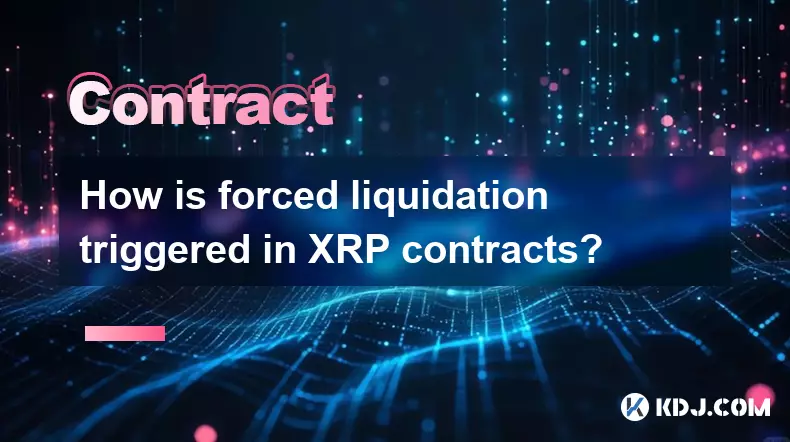-
 bitcoin
bitcoin $122090.672462 USD
1.59% -
 ethereum
ethereum $4493.758974 USD
0.56% -
 xrp
xrp $3.033145 USD
0.65% -
 tether
tether $1.000629 USD
0.00% -
 bnb
bnb $1169.854250 USD
7.07% -
 solana
solana $230.954786 USD
-0.19% -
 usd-coin
usd-coin $0.999785 USD
0.00% -
 dogecoin
dogecoin $0.256108 USD
-1.12% -
 tron
tron $0.342333 USD
-0.12% -
 cardano
cardano $0.859632 USD
-0.10% -
 hyperliquid
hyperliquid $48.932146 USD
-2.25% -
 chainlink
chainlink $22.345466 USD
-1.29% -
 ethena-usde
ethena-usde $1.000217 USD
-0.03% -
 avalanche
avalanche $31.203456 USD
1.93% -
 sui
sui $3.579145 USD
1.05%
How is forced liquidation triggered in XRP contracts?
Forced liquidation in XRP contracts occurs when margin falls below maintenance levels, triggering automatic position closure to limit risk.
Sep 30, 2025 at 11:18 pm

Understanding Forced Liquidation in XRP Contracts
Forced liquidation in XRP contracts occurs when a trader’s margin balance falls below the required maintenance threshold. This mechanism protects exchanges and clearinghouses from counterparty risk when leveraged positions move sharply against the holder. In the volatile environment of cryptocurrency derivatives, especially those involving XRP, price swings can be extreme, making liquidation a common occurrence for over-leveraged traders.
When a trader uses leverage to open a position in XRP futures or perpetual swaps, they are essentially borrowing funds to increase their exposure. The exchange requires a certain amount of collateral—known as initial margin—to open such a position. As the market moves, the value of the position changes, affecting the equity in the trader’s account. If losses accumulate and the equity drops to the maintenance margin level, the system issues a margin call or automatically triggers liquidation.
Key Triggers for Liquidation
- 1. Price movement against the open position reduces the unrealized P&L significantly, dragging down the wallet balance.
- 2. Insufficient margin balance to meet the maintenance requirement set by the exchange’s risk engine.
- 3. Failure to add additional funds during rapid market downturns or flash crashes in XRP value.
- 4. High leverage ratios amplify small price movements, increasing the likelihood of breaching liquidation thresholds.
- 5. Funding rate pressures in perpetual contracts that erode account equity over time if the position direction opposes prevailing funding flows.
Role of Mark Price in Liquidations
Exchanges do not rely solely on the last traded price to determine liquidation status. Instead, they use a mark price, which is an estimated fair value of the contract derived from spot prices and funding rates across multiple platforms. This prevents manipulation and avoids premature liquidations during short-lived spikes or dips.
- 1. The mark price is updated continuously and used to calculate the current value of open positions.
- 2. If the mark price hits the liquidation price, the position is flagged for closure regardless of the last traded price.
- 3. Arbitrage mechanisms help keep the mark price aligned with real-world XRP valuation.
- 4. Using the mark price ensures fairness, particularly during periods of low liquidity or high volatility.
Liquidation Process and Consequences
Once triggered, the liquidation process unfolds rapidly. The exchange’s engine closes the position either through a partial or full unwind, depending on the platform’s design. Some systems use an insurance fund to cover residual losses, while others may socialize losses under extreme conditions.
- 1. The position is closed at the prevailing market or mark price, often resulting in a total loss of margin.
- 2. A liquidation fee may be charged, deducted directly from the remaining balance.
- 3. Partial liquidations may occur on tiered margin systems where only a portion of the position is closed to restore margin health.
- 4. Traders lose not only their initial stake but also any unrealized gains accumulated before the trigger.
Frequently Asked Questions
What is the difference between liquidation price and bankruptcy price?The liquidation price is the market level at which a position is forcibly closed due to insufficient margin. The bankruptcy price is the theoretical point at which the entire margin would be depleted based on the position size and leverage. Liquidation typically occurs slightly before reaching the bankruptcy price to allow for fees and slippage.
Can I avoid liquidation in XRP contracts?Yes, by using lower leverage, monitoring your margin ratio closely, setting stop-loss orders, and maintaining extra funds in your account to absorb adverse moves. Active risk management reduces the chances of being caught off guard by sudden XRP price shifts.
Do all exchanges handle XRP liquidations the same way?No, each exchange implements its own risk parameters, including maintenance margin rates, mark price methodology, and liquidation engines. Some use auction-based models, while others rely on automatic matching. It’s essential to understand the specific rules of the platform you’re trading on.
What happens to my position after it's liquidated?After liquidation, your position is fully or partially closed. Any remaining balance, if applicable, stays in your account minus fees. You cannot recover the position unless you open a new one. The system resets your exposure to prevent further losses.
Disclaimer:info@kdj.com
The information provided is not trading advice. kdj.com does not assume any responsibility for any investments made based on the information provided in this article. Cryptocurrencies are highly volatile and it is highly recommended that you invest with caution after thorough research!
If you believe that the content used on this website infringes your copyright, please contact us immediately (info@kdj.com) and we will delete it promptly.
- BlockDAG, DOGE, HYPE Sponsorship: Crypto Trends Shaping 2025
- 2025-10-01 00:25:13
- Deutsche Börse and Circle: A StableCoin Adoption Powerhouse in Europe
- 2025-10-01 00:25:13
- BlockDAG's Presale Buzz: Is It the Crypto to Watch in October 2025?
- 2025-10-01 00:30:13
- Bitcoin, Crypto, and IQ: When Genius Meets Digital Gold?
- 2025-10-01 00:30:13
- Stablecoins, American Innovation, and Wallet Tokens: The Next Frontier
- 2025-10-01 00:35:12
- NBU, Coins, and Crypto in Ukraine: A New Yorker's Take
- 2025-10-01 00:45:14
Related knowledge

What is the difference between futures and perpetual contracts for Bitcoin?
Oct 02,2025 at 11:54pm
Understanding Bitcoin Futures Contracts1. Bitcoin futures are derivative instruments that allow traders to speculate on the future price of Bitcoin at...

What is the best time to trade PEPE contracts?
Oct 03,2025 at 11:54am
Understanding PEPE Contract Volatility1. PEPE contracts exhibit extreme price fluctuations due to their meme-based nature and low market cap. Trading ...

What are the common mistakes to avoid with Bitcoincoin contracts?
Oct 03,2025 at 08:54am
Emerging Trends in the Cryptocurrency Market1. Decentralized finance (DeFi) platforms continue to expand their influence across the blockchain ecosyst...

What is the maintenance margin for Bitcoin contracts?
Oct 02,2025 at 01:36am
Decentralized Exchanges Gain Momentum in 20241. Decentralized exchanges (DEXs) have seen a significant rise in trading volume, surpassing centralized ...

How to use technical analysis for trading XRP contracts?
Oct 03,2025 at 01:18pm
Understanding Price Patterns in XRP Futures1. Identifying chart patterns such as triangles, head and shoulders, and double tops or bottoms can provide...

What does "longing" PEPE contracts mean?
Oct 03,2025 at 11:54pm
Understanding Decentralized Exchanges in the Crypto Ecosystem1. Decentralized exchanges (DEXs) operate without a central authority, allowing users to ...

What is the difference between futures and perpetual contracts for Bitcoin?
Oct 02,2025 at 11:54pm
Understanding Bitcoin Futures Contracts1. Bitcoin futures are derivative instruments that allow traders to speculate on the future price of Bitcoin at...

What is the best time to trade PEPE contracts?
Oct 03,2025 at 11:54am
Understanding PEPE Contract Volatility1. PEPE contracts exhibit extreme price fluctuations due to their meme-based nature and low market cap. Trading ...

What are the common mistakes to avoid with Bitcoincoin contracts?
Oct 03,2025 at 08:54am
Emerging Trends in the Cryptocurrency Market1. Decentralized finance (DeFi) platforms continue to expand their influence across the blockchain ecosyst...

What is the maintenance margin for Bitcoin contracts?
Oct 02,2025 at 01:36am
Decentralized Exchanges Gain Momentum in 20241. Decentralized exchanges (DEXs) have seen a significant rise in trading volume, surpassing centralized ...

How to use technical analysis for trading XRP contracts?
Oct 03,2025 at 01:18pm
Understanding Price Patterns in XRP Futures1. Identifying chart patterns such as triangles, head and shoulders, and double tops or bottoms can provide...

What does "longing" PEPE contracts mean?
Oct 03,2025 at 11:54pm
Understanding Decentralized Exchanges in the Crypto Ecosystem1. Decentralized exchanges (DEXs) operate without a central authority, allowing users to ...
See all articles










































































